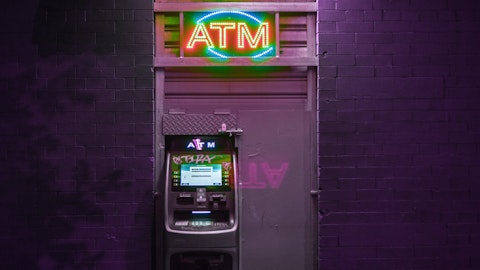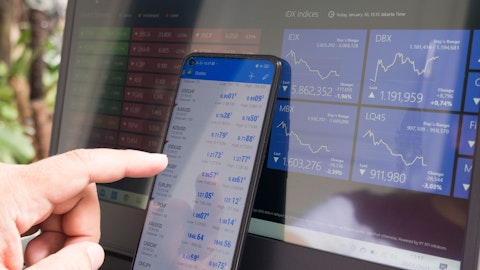Terry Dolan: Thanks Erika.
Operator: And next, we can go to Mike Mayo with Wells Fargo Securities. Please go ahead.
Terry Dolan: Good morning Mike.
Mike Mayo: Hi. Hey good morning. I just wanted to clarify. So, you made your positive operating leverage in 2022 over 200 basis points. If you back into the numbers, I’m getting positive operating leverage year-over-year all-in of somewhere between, I don’t know, 100 to 900 basis points. I’m not sure if that’s correct. And if you back in the numbers, what do you get? And why the such big variance in the revenue guide? That’s a $29 billion versus $31 billion. And why is the margin still increasing five to 10 basis points in the fourth quarter? That’s a bit more of an improvement versus others.
Andy Cecere: I’ll start on a couple of things and then Terry will add in. So, let me sort of go backwards on your questions. The margin is increasing principally because of the value of the low-cost deposits that Union Bank brings on. We talked about that a lot, Mike, and $85 billion of principally consumer low-cost, stable deposits in this environment is very valuable in driving up that margin on a quarterly basis. And that’s reflected in that five to 10 basis points. We did achieve 230 basis points of positive operating leverage in 2020 — hearing a little bit of background.
George Andersen: Hey Mike, we’re getting a little background. Can you mute your line? Thanks.
Andy Cecere: We did achieve 230 basis points of positive operating leverage in 2022. We would expect to achieve continued positive operating leverage into 2023. But 2023 is going to have the merger-related charges in it as well. So I’m looking at it on a core basis. And Terry, what would you add?
Terry Dolan: Yes. Just maybe kind of coming back to the net interest margin, we expect see lift related to Union Bank coming on, that five to 10 basis points and then from there, kind of flattish to maybe moderate increase or expansion in net interest margin through the rest of the year. But clearly, deposit betas and things like that are going to accelerate a bit in 2023.
Mike Mayo: And as a follow-up, look, U.S. Bancorp had been a low cost producer for a long time. It looks like you’re going to trend back in that direction. So it sounds like you still have no change in expected synergies. I get it, Union Bank is performing better, and that’s why the accretion you had brought higher, the 8% to 9%. But still no change in expected synergies from the acquisition? And then separate from that, Andy, you mentioned in December that the big tech investment cycle is now turning positive versus being a drag the last five-or-so years. If you could elaborate on that? Thank you.
Andy Cecere: Sure, Mike. And you’re right, we still are projecting, as Terry went through, $900 million of cost savings, 35% in 2023, 100% fully implemented in 2024. Importantly, we have not in the guidance that we provided, provided any revenue synergies. So it’s without revenue synergies, which we think there are going to be some particularly after the integration and conversion process. We are past the heavy spend on tech. You’re right, we’re more of a flat line and starting to gain the benefits of that. And part of the benefit of this transaction is leveraging the investments we’ve made in the company over the last three or four years to allow us to lift and shift to our technology platform in a very low cost way. So that benefit is driving through the synergies that we talk about.
Mike Mayo: Thank you.
Andy Cecere: Thanks Mike.
Operator: And now we’ll go to John Pancari with Evercore ISI. Please go ahead.
Andy Cecere: Good morning John.
Terry Dolan: Hi John.
John Pancari: Good morning. So on the credit metrics, I know you indicated that you’re starting to see normalization in charge-offs and delinquencies. I want to see if you can elaborate a bit more. In what income cohorts are you seeing the normalization? We’re hearing from some of the consumer finance players that they are seeing some normalization impacting — or moving beyond just the non-prime and low income but into prime and super prime? And also what asset classes are you seeing the normalization most obviously? Is it just on the card side or in other asset classes? Thanks.
Terry Dolan: Yeah. I mean I — this is Terry. So maybe to address your first question in terms of where we’re seeing it and maybe as a reminder, from an underwriting perspective, we focus on prime, super prime really in all of our consumer portfolios. To the extent that we’re seeing delinquencies starting to tick up, it’s more so in the credit card space. And you’re right; it would be probably on the lower bands as opposed to the upper bands at this particular point in time. But one of the things we talked about is that when you look at savings or excess savings from a consumer perspective, they’re fairly significant. That is coming down as that’s coming down; people are revolving more on their credit cards. And I think it’s just kind of a natural progression that we are seeing. And again, starting more with the unsecured and the credit card portfolio, not as much with respect to the other portfolios yet. But as things continue to normalize, we would expect that too.
John Pancari: Okay. Thanks. Terry, that’s helpful. And then I guess related, how does this development in consumer behavior and your macro assumptions as well, how does that impact your expectations for your payments revenue and your card revenue and merchant processing revenue as you look out through the year, considering the macro dynamics? Thanks.
Andy Cecere: Yeah. So the payments revenues, you saw, still is well above pre-COVID levels. The card spend is 25% above. On a year-over-year basis, we’re plus 5%. So spend continues to be strong. The categories of spend are shifting a little bit. And we would expect continued strong spend, but moderating a bit as we go into the rest of 2023 for the reasons that Terry mentioned. But still expect growth but again, probably more moderate in nature as we go forward and the savings level start to normalize and the consumer behavior starts to change.
Terry Dolan: Yeah. And the thing that I would end up adding, John, is that one of the things we’ve talked about in the merchant processing is that, we think that business is kind of a high single digits and when we look at 2023, that’s kind of our expectation for that particular business. Relative to 2022, we anticipate that our credit card revenue or card revenue will strengthen a bit in terms of year-over-year comparisons. And that is primarily because prepaid sales and prepaid revenue, which has been a drag, kind of starts to moderate. And then on the corporate payment card business, we continue to think that that’s going to be reasonably strong, certainly high single digits, if not low double digits. And that’s €“ we’re continuing to see travel and entertainment recover very nicely in that particular space. So we feel pretty good about the payment revenue trends for 2023.
John Pancari: Great. Thank you, Terry. Appreciate it.
Terry Dolan: Yep.
Operator: Next, we go to Ebrahim Poonawala with Bank of America. Please go ahead.
Ebrahim Poonawala: Hey, good morning.
Terry Dolan: Good morning, Ebrahim.





